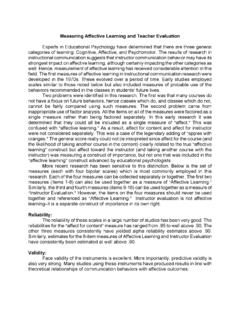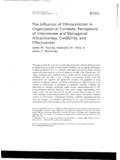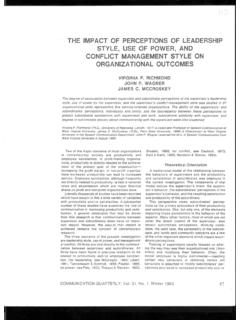Transcription of James C. McCroskey CLASSROOM I: TEACHER AND …
1 Li~ ,"thetraditionalviewofeducation,a viewthatstillprevails,holdsthatlearnersm ustsubmitthemselvestoteachers"(Menges,19 77, ).AsMengesfurthersuggests,thisviewmeanst hattheteachers' , ,Scott,andMcCroskey(1978)suggestthatina classroomsetting"acertaindegreeofteacher powerisalwayspresent"( ). employedbytheteacherasa meansofcontrol,themorelikelyit willberequiredasa "themoreit is used,themoreit willneedtobeused"( ).Theprimaryfocusofthisstudyis ,ofcourse, ,ifthestudentdoesn'tlikethetypeofpowerem ployedbytheteacherbutcanrecognizeitwheni t is , ( ,learning). ,ScottandMcCroskey(1978)havestatedit,the reis"adifferencebetweenknowingandteachin g,andthatdifferenceiscommunicationinthec lassroom"( ). notused,forallintentsandpurposes, ,therefore,theteacherintheclassroomis ,theway(s)theteachercommunicateswithher/ hisstudentstoa 'personfortheDepartmentofSpeechCommunica tion,WestVirginiaUniversity, AssociateProfessorandDirectorofGraduateP rogramsfortheDepartmentofSpeechCommunica tionatthesameinstitution,COMMUNICATIONED UCATION, ,thetypeofpowerexertedwillhavea "Power"is a termcommonlyemployedina ,theconstituentdefinitionsofthetermarefa rfromconsistentfromonedisciplinetoanothe r,orevenwithina "power" ,wewillexamineonlya providedbyHurt,et aI.
2 (1978, ):"Powerreferstoa TEACHER 'sabilitytoaffectinsomewaythestud ent'swell-beingbeyondthestudent'sowncont roL" , ,wehastentoaddthatourexperienceswithhund redsofin-serviceteachersinworkshopsandse minarsindicatesthatthe"laydefinition"ofm ostoftheseindividualsishighlyconsistentw iththeHurt,etaI., numberofotherwriters( ,1968;Goldner,1970;McClelland,1975;Zalez nik&KetsdeVries,1975).Poweris typicallydefinedbythesewritersasanindivi dual'spotentialtohaveaneffectonanotherpe rson'sorgroupofpersons' \110respecifically,thisbroaderviewseespo werasthecapacitytoinfluenceanotherperson todosomethinghe/ ,anindividualexhibitssometypeofchangeinh er/hisbehavior,attitudes,beliefs,etc.,as a ,FrenchandRaven(1968)qualifythistypeofde finitionbynotingthatsuchchangemustbea directresultoftheinfluenceexertedbyanoth erratherthantheresultofa ,FrenchandRaven(1968)identifiedfivepoten tialbasesofpower:coercive,reward,legitim ate,referent, 's(1968) (1968)werenotwritingwiththeclassroomasth eirintendedfocus, 'scoercivepowerisbasedona student'sexpectationsthathe/shewillbepun ishedbytheteacherifhe/shedoesnotconformt otheteacher' 'scoercivepoweriscontin-gentuponthestude nt'sperceptionofhowprobableit is thattheteacherwillexactpunishmentfornon- conformanceandthedegreeofnegativeconsequ encessuchpunishmentwouldentail,minusthep robabilityofpunishmentfromothersources( ,thebehavioritself,etc.)
3 If thestudentdoescomplywiththeteacher' ,theteachermayhavenocoercivepoweratall,e venthoughtheteachermaybeina positiontoexerta TEACHER 'srewardpoweris basedona student'sperceptionofthedegreetowhichthe teacherisinapositiontoproviderewardtoher /himforcomplyingwiththeteacher' (positivereinforcement)orremovingsomethi ngnegative(nega-tivereinforcement).Aswas thecasewithcoercivepower,thestrengthofa TEACHER 'srewardpowerismediatedbythepossi bilityofreceivingotherrewardsfromotherso urcesasa is oftennotrecognized, referredtoas"assigned" 'sperceptionthattheteacherhastherighttom akecertaindemandsandrequestsasa functionofher/hispositionas" TEACHER ."Thi stypeofpowergenerallyismostrelatedtomund anematters,suchascontrollingclassroomtim e,determiningwhatunitshouldbestudied,reg ulatinginteraction, ,however, "legitimate" ' ,itisbasedonthedesireofthelesspowerfulpe rson(thestudent)toidentifywithandpleaset hemorepowerfulperson( TEACHER ).
4 Thestrongerthestudent'sattractiontoandid entificationwiththeteacher,thestrongerth eteacher' presentedfroma "proven" , (1968)stressthatthemainimpactofexpertpow eris changeinanindividual' , ,poweris teachertellsa studenttodoher/hishomework,itusuallyis notnecessarytosay"orI willpunishyoubyloweringyourgrade"or"beca useI amtheteacherandI havetherighttodemandyoudothis"or"because youlikemeandwanttopleaseme." , ,forexample,178-COMMUNICATIONEDUCATION maybeinvokedwhena teachersays"Ifyoudon'tturnyourworkinonti me,I willgiveyouan'F'fortheassignment."Simila rly,rewardpowermaybeinvokedwhenateachers ays"Ifyoudothisextraproblem,I willgiveyoufivebonuspoints."Anappealtore ferentpowermaytaketheformoftheteachersay ing"Willsomeonehelpmesetupthisfilmprojec tor?"Whetherpowerappealsaredirectlystate dorimplied, thestudentdoesnotperceivetheteachertohav ea certaintypeofpower,a TEACHER 'sappealtothatpower,whetherdirect orimplied,is ,evenifthestudentperceivestheteachertoha vethepower,if theinfluenceattemptisnotassociatedwithth epower,theattemptis teachercannotavoidusingpowerintheclassro om,thatuseofpoweris ,it :1).
5 Todetermineanacceptablemethodofmeasuring useofpowerintheclassroom,and2)todetermin ethedegreetowhichteachersandstudentshave sharedperceptionsoftheuseof , , (1968)asthefoundationforourworkinthisare a,it ,Student(1968) (1968)conceptualization,Student(1968)pro videdsubjectswitha descriptionofeachtypeofpowerandaskedthem toestimate(ona five-point,Likert-typescale)theextenttow hichtheycompliedwiththeirsupervisor' modificationoftheStudent(1968)approachwa sintroducedbyRichmond,McCrosky,Davis,and Koontz(1980).Theirresearchwasfocusedonor ganizationalcommunicationandemployeda varietyofemployeesamples, :TEACHERANDSTUDENTPERCEPTIONS-!79reliabi lityofthesingle-itemtypemeasureusedbyStu dent(1980),Richmond,et al.(1980)employedfiveseven-point, descriptionofeachtypeofpowerandaskedthes tudentstorespondtothefollowingstatementf oreachtypeofpoweronthefivescales:"tvrysu pervisoremployspower." :agree-disagree,false-true,incorrect-cor rect,wrong-right, (MCS) ,etal.
6 (1980) (pptvr). "Iusepower."Whenoursubjectswerestudents, thestatementread."Myteacherusespower."As wewillreportlater,thereliabilitiesweobta inedwereveryhighandcomparabletothoserepo rtedbyRichmond,etal.(1980).Whilethisinst rumentishighlyreliableandhas,inslightlyd ifferentforms,afairlygoodcaseforvalidity ,it is possiblefora powersourcetoberatedextremelyhighly(oran yotherlevel) 'suse,weemployeda (RPM). thenrequeststhesubjectstoestimatetheperc entageoftotalpowerusagethatstemsfromeach base, ,theinstrumentforteacherstakesthefollowi ngform:Presumingthat100percentrepresents allofthepowerthatyouusewithyourstudents, pleaseestimatethepercentagewhichyouusein eachof ,if youusea lotofcoercivepowerbutlittleelse,youmight respondasfollows:80coercive,5 reward,5 legitimate,5referent,5 ,then, moreabsoluteform,whiletheRPtvIwasdesigne dtomeasurepoweruseina !Anadditional4 , ,teachersandclassesfromsciences,humaniti es,socialsciences, , (over35) , , ,or20percent, ,onthebasisofthelegiblepostmarksandretur naddressesofthematerialsreturned, ,it , ,it ,eachteacherwasaskedtoselectafive-digitn umberatrandomandtorecordit ) ) )Thesemeansweretested(t-testforrelatedsa mples) ) ) , desirable,it ,theuseofa singleitemtomeasureperceivedpowerforeach base,asemployedbyStudent(1968), :TEACHERANDSTUDENTPERCEPTIONS-181 TABLEIALPHARELIABILITYESTIMATES arereportedinTable2.
7 Thedifferencesbetweenteacherandstudentsc oresoneachmeasurearealsoreportedinthatta bleasaretheobtainedt' ,however, highproportionofreward,referent, ,asindicatedbytheRPMscores,bothteachersa ndstudentsreportgreateruseofexpert,refer ent, ,studentssawcoercivepowerasaccountingfor a higherproportionofpowFrusethandidteacher s,whileteacherssawa (rc=.53,P <.001) (rc= .37,P <.001)wasprimarilya (rc= .33,P <.01)wasmostassociatedwithstudentandteac herperceptionsofrewardandreferentpower.( SeeTable3forcorrelationsofallpowervariab leswiththevariates.) ,t-TEST, ".. ".. ". ". " ** <.05up< .01."p< .001182-COMMUNICATIONEDUCATIONTABLE3 CORREL.\TIONCOEFFICIE:-<TSFORSIGNIFICANT CANONICALVARIATES-PPMDATA!\ (rc=.50,p < .001) (rc=.38,P <.05)wasmostassociatedwithreportsconcern ingrewardandexpertpower.(SeeTable3 forcorrelationsofallpowervariableswithth evariates.) ,withthehighest(r= .46) , ,thehighestassociationwasforcoercivepowe r(r=.)
8 37). ,theresultsobtainedonthePPMandtheearlier resultsobtainedbyStudent(1968) ,then, ,althoughthereissubstantialandstatistica llysignificantassociationbetweentheseper ceptions, ,theobservedcorrelationswerestatisticall ysignificant, ,evenatbest,theteachersandstudentsshareo nlya [ :-'(VariateIVariate2( :TEACHERANDSTUDENTPERCEPTIONS-183negativ elyandreward,referent,andexpertpowerposi tively(asis suggestedinmuchoftheeducationliterature) ,it is clearthattheteachershavea ,however,bothteachers( )andstudents( )seetheoverwhelmingproportionofpoweruset ostemfromreward,referent, ,it wouldnotbecorrecttoconcludefromthisstudy thatteachersseetheirbehaviorina positivelightwhilestudentsseeitina generallypositiveview,buttheteacherviewi s , ,whilethelargestontheRP~ somewhatmorenegativeviewoftheirteacher's powerusagethantheteacherdoes,thegenerall ymodestcorrelationsbetweenteacherandstud entperceptionsindicatethatmanystudentsha veamorepositiveviewoftheirteacher' ,andthedifferentialperceptionscannotbesi mplyexplainedbyself-servinginterests,the questionthatneedstobeaddressedis,whosepe rceptionsareright?)]
9 Or,toputitanotherway,whoseperceptionssho uldberesearched?Whilewedonotwishtotakean absolutistapproachtorightandwrongonthisi ssue,wedobelievethattheperceptionsofthes tudentsarethemorecriticalperceptions, , 'sbehavior,whilecertainlyaffectedbywhatt heteacherthinksanddoes, ,webelieve,theimpactofteachers'useofpowe rintheclassroomonstudentlearningis mediatedbythestudents' 'perceptionsoftheirpowerusageandstudentl earning, ' ;however,it prioripowerofthetestassuminga ! ,sucha possibleinteractioncouldnotbeinvestigate dinthisstudyand,thus,remainsa ,&Zander,A.(Eds.) :Harper&Row, ' , (Ed.),Studiestn'( :UniversityofMichiganPress, ~I. (Ed.),PowertnorfJanzzl1twns. :>l:VanderbiltL'niversitvPress, , ,Scott, ,& McCroskey , ,MA:Addison-Wesley, , :IrvingPublishersInc., , , ,CA:Brooks/Cole, , , McCroskey , ,Davis, ,&Koontz, mediatorofmanagementcommunicationstylean demployeesatisfaction:Apreliminaryinvest igation,CommunicationQuarterly,Fall198O, , ,1968,52, ,A.)
10 ,&KetsdeVries, :HoughtonMifflinCo., \\ '\O\:. \:.S'1\:.O"'\:.~\:. ' \.~ """,SpeechCommunicationAssociation\






